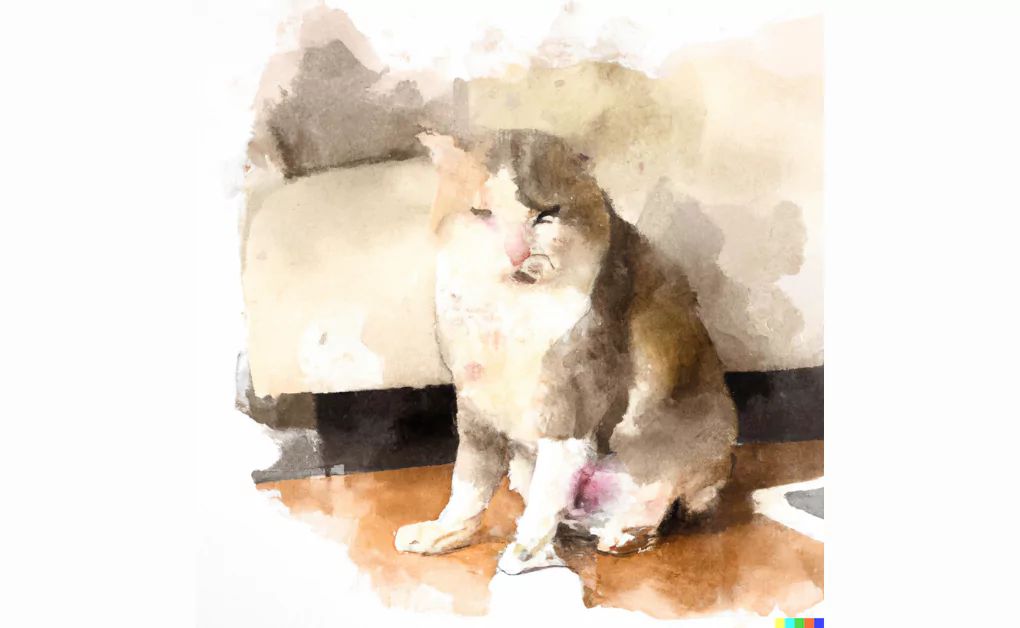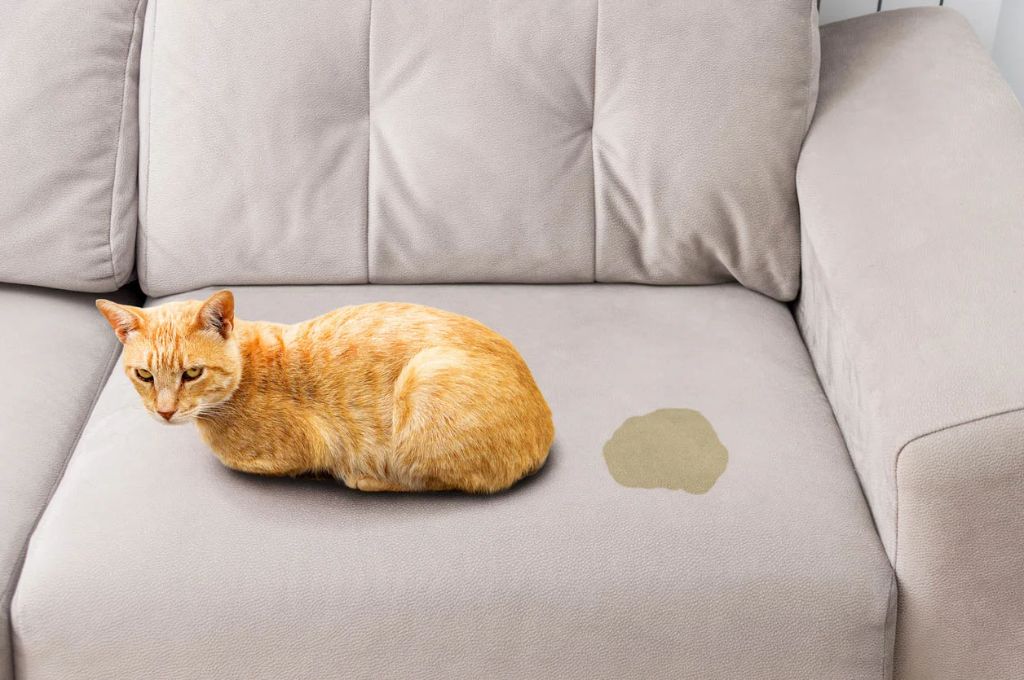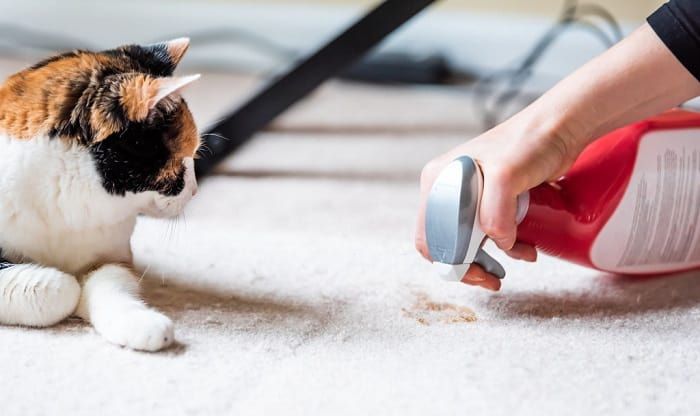Cat urine smells are a common issue that many cat owners face. According to a survey in 2010, around 11% of cat owners reported issues with cat urine odors, down from 19% a decade earlier.
The strong ammonia odor from cat urine is unpleasant and can linger for a long time if not properly cleaned. Prolonged exposure to cat urine smells can also pose potential health hazards to humans.
Cats urinate outside their litter box for a number of reasons including medical issues, anxiety, marking territory, or dissatisfaction with the litter box. Identifying and addressing the underlying cause is important, but dealing with the lingering odors is also a priority.
This guide provides helpful tips and techniques for removing cat urine odors from carpets, floors, walls and other surfaces. It covers products, home remedies, professional services, and prevention methods. With the right approach, you can successfully tackle cat urine smells and maintain a fresh environment.
Assess the Situation

The first step in eliminating a cat urine smell is to thoroughly assess the situation to determine where the odor is coming from. Start by walking through each room and sniffing carefully to locate the source. Pay special attention to corners, baseboards, walls, and flooring, as urine can soak into these areas.
Check for visual signs of urine marking such as stains or wet spots. Look along baseboards, behind furniture, and under beds and cabinets. Use a blacklight to detect dried urine stains that may be invisible to the naked eye. Dark spots will glow under the blacklight indicating the presence of dried urine (Source).
If you cannot find any visible evidence, try getting down on the floor and sniffing at ground level. The urine smell may be isolated in a specific area or widespread throughout a room. Determine which rooms are affected and the strongest odor locations.
Finding the urine source is crucial for effective treatment. Spend time thoroughly checking each room and using your nose to hone in on the spot. Once the exact location is identified, you can begin clean up and odor removal.
Clean the Area
The first step in removing cat urine smells is to thoroughly clean the soiled area. It’s important to use the right cleaning solutions to break down the urine enzymes and fully eliminate odors. Vinegar and baking soda work well to effectively neutralize urine smells. Enzyme cleaners specifically designed for pet stains are also highly effective.
Start by soaking up as much of the urine as possible with paper towels. You may need to press down firmly and let the towels sit for a few minutes to absorb all the liquid. Once the area is mostly dry, spray it generously with white vinegar. Let the vinegar soak in for 5-10 minutes.
Next, sprinkle a thick layer of baking soda over the area and let it sit for at least 15 minutes. The baking soda will help draw out any remaining moisture and urine. After 15 minutes, vacuum up the baking soda.
As a final cleaning step, apply an enzyme cleaner made for pet stains. Follow the product instructions closely. Enzyme cleaners work at the molecular level to completely eliminate urine odors. Let the enzyme cleaner soak in for at least 10 minutes before wiping it away.
It may take 2-3 rounds of vinegar, baking soda, and enzyme cleaner to fully eliminate odors from carpet, wood, concrete or other surfaces. Be patient and keep cleaning until all traces of odor are gone.
Deodorize and Neutralize

Eliminating the smell is crucial for removing cat urine odors. There are a few effective ways to deodorize and neutralize urine smells.
Activated charcoal can absorb and neutralize odors. Placing bowls of activated charcoal around the soiled area can help absorb lingering odors over time. Replace the charcoal every few days until the smell dissipates. Activated charcoal air purifiers can also circulate air and trap odors [1].
Using an air purifier with a HEPA filter can also help remove urine odors from the air. Place the air purifier near the soiled area and let it run continuously until the smell is gone [2]. The HEPA filter will trap urine particles and prevent them from recirculating in the air.
Block Re-Marking
Once you’ve thoroughly cleaned the soiled areas, you’ll need to take steps to prevent your cat from re-marking the same spots. Here are some tips:
Use cat repellent sprays designed to deter cats from spraying in an area. Products like Sentry Stop That! contain pheromones that signal to cats that the area is not appropriate for marking. Be sure to follow the manufacturer’s instructions.
Restrict access to previously soiled areas as much as possible. Close doors, block access with furniture or baby gates, or place sticky tape like Sticky Paws down to make the area less appealing. This is especially helpful for carpeted areas that tend to soak up odors.
Place litter boxes and scratching posts near previous accident sites to encourage more appropriate elimination behaviors. Make sure your cat has enough litter boxes – the general rule is one per cat, plus one extra.
Try synthetic feline facial pheromone sprays like Feliway to help reduce anxiety and prevent marking. Use them on furniture, walls, doorways, etc.
If necessary, confine your cat to a single room with food, water, toys, and a litter box until the behavior ceases. This limits access to previously soiled areas.
Remove Odors from Carpet
Carpets tend to absorb urine odors, so it’s important to act quickly to remove the smell. There are a few homemade solutions using common household ingredients that can help eliminate cat urine odors from carpets.

One of the most effective ingredients is baking soda. Start by blotting up as much of the urine as possible from the carpet with paper towels. Liberally sprinkle baking soda over the stain and let sit for several hours or overnight to allow time for the baking soda to absorb the odor. Then, vacuum up the baking soda. The baking soda will help neutralize the acid in cat urine that causes the odor (Source).
Creating a solution with hydrogen peroxide is another handy method. Mix together 1 part hydrogen peroxide with 1 part water. Use a spray bottle to evenly coat the stain, let sit for 5 minutes, and blot dry with a clean towel. The hydrogen peroxide helps remove the urine odor and lift the stain (Source).
For stubborn odors, repeat either treatment as needed until the urine smell is completely gone. It’s best to thoroughly clean and deodorize the carpet as soon as possible after an accident to prevent the smell from setting in.
Remove Odors from Wood
For wooden furniture or flooring that has been urinated on by a cat, one effective method is using vinegar. Make a solution of equal parts white vinegar and water. Using a spray bottle, liberally spray the solution onto the affected area of wood. Allow it to soak in for several minutes. The acetic acid in vinegar helps to neutralize and break down the compounds causing the urine odor. Gently blot and scrub with a soft cloth or sponge.
For more stubborn odors that have really soaked into the wood, you may need to lightly sand and refinish the surface of the wood after cleaning with vinegar. Use fine grit sandpaper and sand gently to avoid damaging the wood. This will remove some of the top layers that have absorbed the urine. Follow up by applying a fresh sealant or finish, like polyurethane. Allow proper drying time according to the product instructions. This should effectively block any remaining odors in the wood.
Vinegar is an inexpensive and effective odor eliminator for cat urine accidents on wood surfaces. When combined with sanding and refinishing for severe cases, you can fully remove urine odors and stains from wooden furniture, floors, cabinets, and more. For more tips, see this guide on removing cat urine from wood furniture (https://shop.truckmountforums.com/blogs/news/how-to-get-cat-urine-out-of-wood-furniture).
Remove Odors from Drywall
Cat urine can soak into drywall and the odor can linger long after the surface has dried. To fully eliminate odors from drywall:

First, find the exact location of the odor by sniffing along the baseboards and wall. Once you’ve identified the area, seal it with an enzyme-based sealer specifically made to neutralize pet odors. Apply several coats, allowing each coat to fully dry before adding the next. This will seal in urine that has soaked into the drywall.
Next, apply an odor-blocking primer to the area, which will further neutralize odors. Once the primer is fully dry, apply two final coats of low-VOC latex paint. The fresh paint will leave your walls looking and smelling good as new.
If the odor persists even after sealing and painting, the urine may have soaked deeper into the drywall or wall cavity. At that point, it’s best to replace the affected drywall to fully eliminate the smell.
Prevent Future Incidents
To prevent your cat from urinating outside the litter box in the future, focus on re-training good litter box habits through positive reinforcement. Make sure the litter box is easily accessible – have at least one litter box per cat, plus one extra, spread throughout your home. Scoop waste from boxes daily and completely replace litter at least once a week. Try different litters or box styles if your cat seems picky. Place boxes away from noisy appliances and high traffic areas for privacy.
Reward your cat with treats and praise every time you see them use the litter box. Limit stress by providing cat towers, scratching posts, and interactive toys for an outlet. Use synthetic feline pheromones like Feliway to help ease anxiety. Avoid punishing or yelling at your cat. If incidents continue, take your cat to the vet to check for underlying medical issues. Be patient and stick to a routine, as re-training takes time.
When to Call a Professional
In severe cases of cat urine contamination, especially if the smell persists after trying DIY solutions, it may be time to call in a professional carpet cleaner or odor removal service. Professionals have commercial-grade cleaners and tools like truck-mounted extraction systems that can deep clean down into the carpet padding and subfloor where odors can linger.
A professional can also identify if the cat may have a medical issue leading to inappropriate urination. Urinary tract infections, kidney disease, diabetes, thyroid problems, anxiety, or other conditions may cause a cat to urinate outside the litter box. A vet check can rule out medical causes so you can better address behavioral issues if needed.
Look for a service experienced in pet odor removal and cat urine specifically. Make sure they use pet-safe cleaners and enzyme treatments meant to fully neutralize the urine. This provides the best chance of getting rid of even persistent smells.

